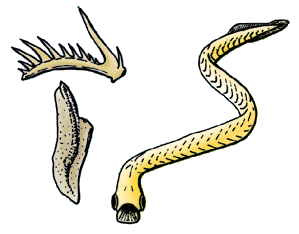Related Research Articles
The Ordovician is a geologic period and system, the second of six periods of the Paleozoic Era. The Ordovician spans 41.6 million years from the end of the Cambrian Period 485.4 million years ago (Mya) to the start of the Silurian Period 443.8 Mya.

Conodonts are extinct agnathan chordates resembling eels, classified in the class Conodonta. For many years, they were known only from tooth-like microfossils found in isolation and now called conodont elements. Knowledge about soft tissues remains limited. The animals are also called Conodontophora to avoid ambiguity.
The Tremadocian is the lowest stage of Ordovician. Together with the later Floian stage it forms the Lower Ordovician epoch. The Tremadocian lasted from 485.4 to 477.7 million years ago. The base of the Tremadocian is defined as the first appearance of the conodont species Iapetognathus fluctivagus at the Global Boundary Stratotype Section and Point (GSSP) section on Newfoundland.
The Furongian is the fourth and final series of the Cambrian. It lasted from 497 to 485.4 million years ago. It succeeds the Miaolingian series of the Cambrian and precedes the Lower Ordovician Tremadocian stage. It is subdivided into three stages: the Paibian, Jiangshanian and the unnamed 10th stage of the Cambrian.
The Darriwilian is the upper stage of the Middle Ordovician. It is preceded by the Dapingian and succeeded by the Upper Ordovician Sandbian stage. The lower boundary of the Darriwilian is defined as the first appearance of the graptolite species Undulograptus austrodentatus around 467.3 million years ago. It lasted for about 8.9 million years until the beginning of the Sandbian around 458.4 million years ago.

Promissum is an extinct genus of conodonts, primitive chordates, that lived during the Upper Ordovician period.
In the geological timescale, the Llandovery epoch occurred at the beginning of the Silurian period. The Llandoverian epoch follows the massive Ordovician-Silurian extinction events, which led to a large decrease in biodiversity and an opening up of ecosystems.
The Whiterockian, often referred to simply as the Whiterock, is an earliest or lowermost stage of the Middle Ordovician. Although the Whiterockian or Whiterock Stage refers mainly to the early Middle Ordovician in North America, it is often used in the older literature in a global sense.
Prioniodontida, also known as the "complex conodonts", is a large clade of conodonts that includes two major evolutionary grades; the Prioniodinina and the Ozarkodinina. It includes many of the more famous conodonts, such as the giant ordovician Promissum (Prioniodinina) from the Soom Shale and the Carboniferous specimens from the Granton Shrimp bed (Ozarkodinina). They are euconodonts, in that their elements are composed of two layers; the crown and the basal body, and are assumed to be a clade.
Westergaardodina is a species-rich genus of spine, U or W-shaped paraconodont known from Middle Cambrian to Lower Ordovician strata.
Iapetognathus is a genus of cordylodan conodonts. It is one of the oldest denticulate euconodont genera known.
Cornuodus is an extinct genus of conodonts.
Paracordylodus is an extinct genus of conodonts in the clade Prioniodontida, also known as the "complex conodonts". The species P. gracilis has been recovered from the chert of the Narooma Terrane, a geological structural region on the south coast of New South Wales, Australia.
Paracordylodontidae is an extinct family of conodonts in the clade Prioniodontida, also known as the "complex conodonts".
Appalachignathus is a genus of multielement conodonts from the Middle Ordovician of North America.
Prioniodus is an extinct genus of conodonts in the family Balognathidae from the Ordovician.
Conodonts are an extinct class of animals whose feeding apparatuses called teeth or elements are common microfossils found in strata dating from the Stage 10 of the Furongian, the fourth and final series of the Cambrian, to the Rhaetian stage of the Late Triassic. These elements can be used alternatively to or in correlation with other types of fossils in the subfield of the stratigraphy named biostratigraphy.
Baltoniodus is an extinct genus of conodonts.
Microzarkodina is an extinct genus of conodonts mainly from the Middle Ordovician of Baltoscandia. The Microzarkodina apparatus probably consisted of 15 or 17 elements: four P, two or four M and nine S elements. The S elements include different Sa, Sb1, Sb2, and Sc element types.
Histiodella is an extinct genus of conodonts.
References
- ↑ Prioniodontacean conodonts from the Emanuel Formation (Lower Ordovician) of Western Australia. RA McTavish, Geologica et Palaeontologica, 1973